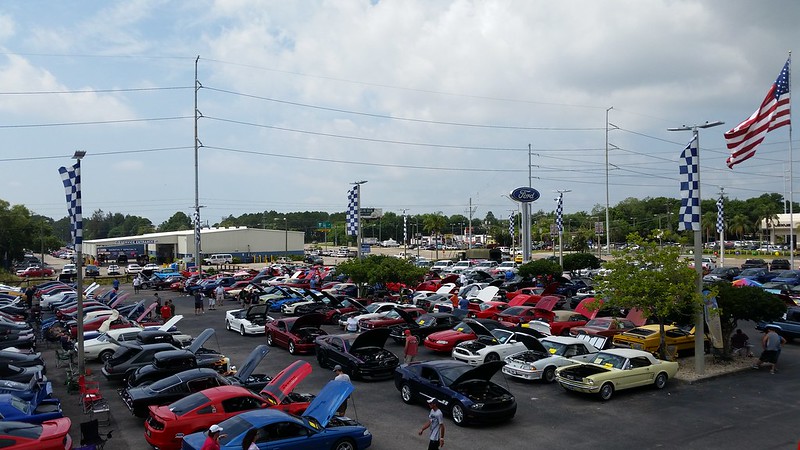As the clock ticks toward April 2, 2025, the global automotive industry is in a frenzy. International carmakers are scrambling to flood the United States with vehicles and critical components, driven by the looming threat of President Donald Trump’s proposed tariffs. These reciprocal levies, set to take effect on what Trump has dubbed “Liberation Day,” could reshape automotive supply chains and send shockwaves through an industry already navigating a complex web of challenges. From Asia to Europe to North America, carmakers rush to ship vehicles to the US in a bid to outpace the deadline, while others weigh long-term strategies like building factories stateside. Here’s a closer look at this high-stakes race and what it means for the road ahead.

A Surge in Shipments: The Tariff Countdown Begins
The announcement of potential 25% tariffs on imports from Mexico and Canada, alongside broader reciprocal tariffs on other trading partners, has lit a fire in the automotive sector. Industry insiders report a noticeable uptick in activity as carmakers rush to ship vehicles to the US before the April 2 deadline. Car-carrying vessels are being dispatched to Asia and Europe, tasked with hauling thousands more vehicles than usual across oceans to American shores.
Lasse Kristoffersen, CEO of Wallenius Wilhelmsen, a titan in vehicle shipping, told the Financial Times that demand is outstripping capacity. “There’s more volume out of Asia than we’re able to take from our customers,” he said, noting that his company has added ships to meet the surge—though a shortage of car carriers limits how much more can be done. Data backs up the frenzy: February saw a 22% year-on-year jump in vehicle shipments from the EU to the US, a 15% rise from South Korea to North America, and a 14% increase from Japan. Stian Omli of Esgian, a car carrier tracking platform, observed a “noticeable increase” in vessels steaming from Europe, with East Asia likely to follow as the deadline nears.
South Korean giants Hyundai and Kia are among those pushing to beat the tariff clock, though Hyundai remained tight-lipped, stating only that it “continuously optimizes shipment plans to adapt to market conditions.” German manufacturers are also in on the action, with one official confirming an uptick in Europe-to-US shipments. Across the border, Honda and Stellantis—parent of Chrysler and Jeep—are hustling to move inventory from Mexico and Canada into the US, taking advantage of a 30-day reprieve Trump granted after his initial tariff pledge.
South Korean giants Hyundai and Kia are among those pushing to beat the tariff clock, though Hyundai remained tight-lipped, stating only that it “continuously optimizes shipment plans to adapt to market conditions.” German manufacturers are also in on the action, with one official confirming an uptick in Europe-to-US shipments. Across the border, Honda and Stellantis—parent of Chrysler and Jeep—are hustling to move inventory from Mexico and Canada into the US, taking advantage of a 30-day reprieve Trump granted after his initial tariff pledge.
Why Carmakers Rush to Ship Vehicles to the US
The motivation is clear: tariffs mean higher costs. A 25% levy on imports from Mexico and Canada, where many automakers have significant production footprints, could spike prices for consumers and squeeze profit margins for companies. Even beyond North America, reciprocal tariffs aimed at balancing trade deficits with countries like South Korea and Japan threaten to upend the economics of selling cars in the US, the world’s second-largest auto market. By stockpiling vehicles stateside now, carmakers hope to dodge the immediate hit and buy time to adapt.
Stellantis CFO Doug Ostermann highlighted the buffer this strategy provides. “We have a pretty good supply on the ground right now with our dealers, probably 70 to 80 days of most of those units,” he said at a recent conference, referring to vehicles produced in Canada and Mexico. Meanwhile, a logistics executive noted that even suppliers of car components—like stereo systems—are joining the rush, aiming to stockpile electronics in the US before duties kick in.
Yet not every player is on board. Toyota, for one, has taken a wait-and-see approach, stating it “has not been increasing vehicle imports” in anticipation of tariffs. Two Japanese car carriers echoed this, reporting little change in demand. For these companies, the uncertainty of the tariffs’ scope and duration may outweigh the benefits of a preemptive shipping spree.
Carmakers Rush to Ship Vehicles to the US: A Global Snapshot
The shipping surge paints a vivid picture of global interdependence in the auto industry. From South Korea’s bustling ports to Europe’s industrial hubs, carmakers rush to ship vehicles to the US as a hedge against policy shifts thousands of miles away. In February alone, the EU’s 22% shipment increase underscored how deeply European brands like Volkswagen and BMW rely on the US market. Japan’s 14% uptick reflects similar stakes for Toyota and Honda, even if their strategies differ. South Korea’s 15% rise signals Hyundai and Kia’s urgency to protect their growing US presence.
Mexico and Canada, meanwhile, are ground zero for the tariff threat. With integrated supply chains spanning the USMCA trade bloc, companies like Honda and Stellantis are racing to shift vehicles and parts across borders before the rules change. This isn’t just about finished cars—electronic suppliers and other component makers are also in the mix, highlighting how tariffs could ripple through every layer of production.
Beyond the Rush: Long-Term Plays and Mixed Signals
While carmakers rush to ship vehicles to the US, some are looking beyond the short-term scramble. Hyundai Steel’s recent announcement of a $5.8 billion steel plant in Louisiana, part of a broader $21 billion Hyundai Motor Group investment in the US, suggests a shift toward domestic production as a tariff shield. Unveiled alongside Trump at the White House, the plan aims to churn out 2.7 million tonnes of steel annually—a move that could soften the blow of import duties on steel and cars alike. Still, it’s unclear if this will sway the administration to grant South Korea exemptions, especially with its trade surplus in the crosshairs.
On the policy front, mixed signals abound. Reports from Automotive News and Bloomberg suggest Trump may delay sector-specific tariffs on autos, pharmaceuticals, and semiconductors past April 2, opting instead for broader reciprocal levies. This shift could ease immediate pressure on carmakers, but Flavio Volpe of the Canadian Automotive Parts Manufacturers’ Association isn’t buying the relief. “With all the layers of tariffs and the stream of new announcements and threats, [it] offers zero comfort,” he said. The uncertainty—how long will tariffs last? Which countries will be hit?—keeps the industry on edge.
Cody Lusk of the American International Automobile Dealers Association summed it up: “We’re all waiting to see. Is each country treated differently? Is everybody the same?” Kristoffersen of Wallenius Wilhelmsen added a broader concern: “The bigger question is how will it affect the car trade over time… Customers are very uncertain which direction this will take.”
The Bigger Picture: Safety, Supply Chains, and Stability
Amid the tariff turmoil, the auto industry faces other persistent challenges. A century after Norman Bel Geddes pitched automated highways to end traffic deaths at the 1939 World’s Fair, the promise of technology-driven safety remains unfulfilled. In 2023, an average of 112 Americans died daily on US roads, per NHTSA data—a grim reminder that innovation hasn’t yet solved every problem. As carmakers rush to ship vehicles to the US, they’re also navigating this ongoing crisis, balancing profit motives with public pressure for safer roads.
Supply chain resilience is another fault line exposed by the tariff threat. The rush to stockpile vehicles and parts reveals how fragile global networks can be when policy shifts loom. Carmakers rush to ship vehicles to the US not just to beat tariffs, but to maintain market share in a competitive landscape where delays or price hikes could push buyers to rivals—or to American-made alternatives.
What’s Next for the Auto Industry?
As April 2 approaches, carmakers rush to ship vehicles to the US with a mix of urgency and unease. The 30-day reprieve has bought breathing room, but the lack of clarity on tariff duration and targets keeps strategies fluid. Will Hyundai’s US factory gambit pay off? Will Toyota’s restraint prove wise? And how will smaller players weather the storm if shipping capacity stays stretched?
For now, the industry is in motion—literally and figuratively. Ports are buzzing, ships are sailing, and factories are humming, all to get ahead of a policy pivot that could redefine the rules of the game. Carmakers rush to ship vehicles to the US today, but tomorrow’s road remains uncharted. As Kristoffersen put it, the real test is what happens “over time”—and that’s a journey no one can fully predict.
